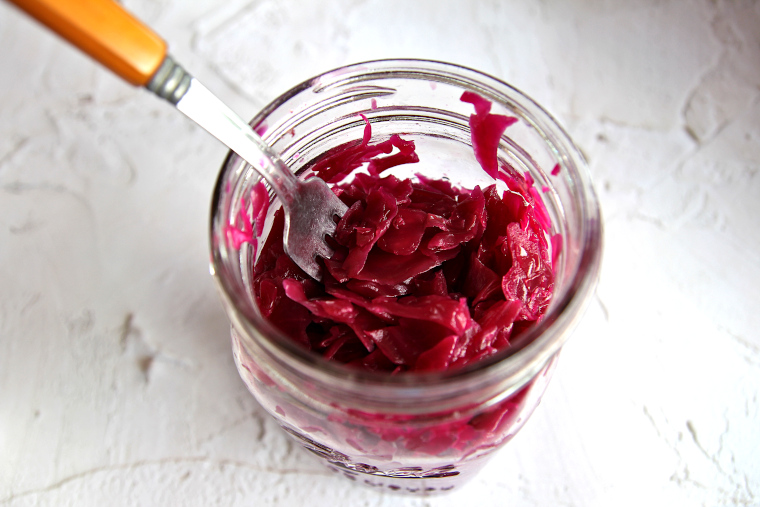
This post may contain affiliate links. See my full disclosure. As an Amazon Associate, I earn from qualifying purchases.
Did you know you can make this beautiful purple sauerkraut in a jar right at home? It’s tangy and gut-healthy, and a delicious condiment or side to add variety and color to your meals. Only a few supplies are needed and no canning is necessary.
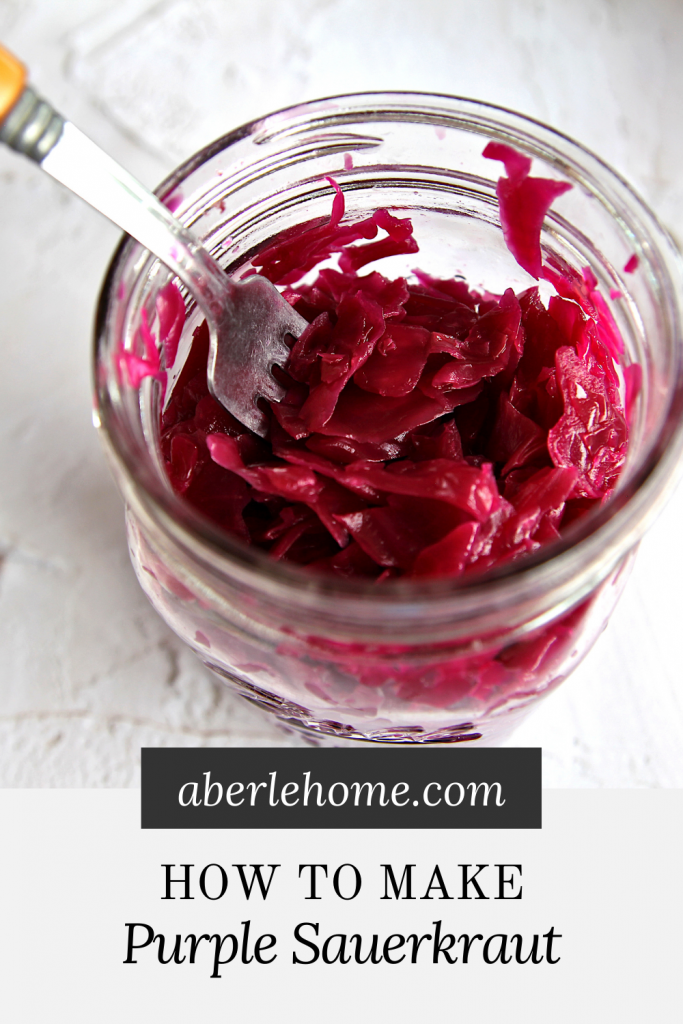
Purple Sauerkraut Benefits
We enjoy making a variety of fermented and cultured foods in our home like sourdough breads, milk kefir, Instant Pot yogurt in jars, lacto-fermented sliced jalapeños, and more.
Fermenting foods is a natural way to add probiotics to your diet. These foods are also more digestible and high in vitamins and minerals. Not to mention, they are full of flavor.

Did you know that canned sauerkraut from the grocery store doesn’t contain probiotics any longer? Heating the kraut during the canning process kills the living, healthy bacteria. It also won’t store long in the fridge once you open the can. This sauerkraut will last 3 months or more in the refrigerator!
I think it’s worth it to eat the fresh stuff!
Can You Really Make Sauerkraut out of Red Cabbage?
You can make fermented purple cabbage the same way that you would ferment green cabbage to make a purple kraut. Red cabbage has a higher vitamin and antioxidant content than green cabbage, to boot.
We love the bright purple color and our kids like it too.
That being said, you can use this same recipe with green cabbage if that’s what you have on hand, and it will work just fine.
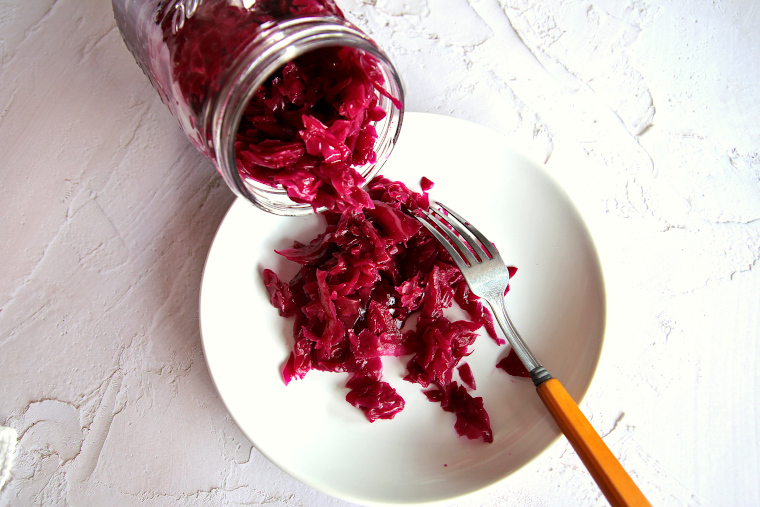
Equipment Needed
- Cutting board and knife (or food processor or mandolin)
- Large bowl
- Kitchen scale
- 32-ounce wide-mouth mason jar with its rim*
- Glass fermentation weight for a wide-mouth jar
- Airlock fermentation lid for a wide-mouth jar
- Plastic lid for a wide mouth jar
*no need to sanitize your jars/weights/lids, but everything should be nice and clean
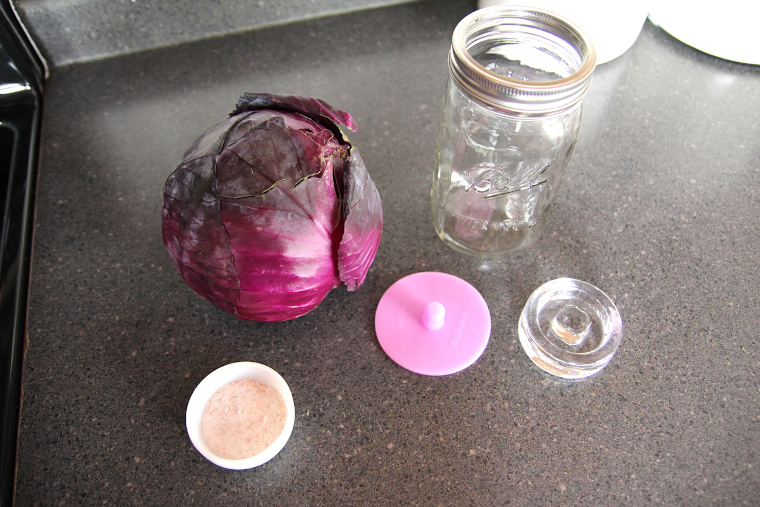
How to Make Purple Sauerkraut
Step 1 – Slice and Dry Brine Red Cabbage
First, remove and discard the outer leaves. Slice your head of cabbage thinly, avoiding the core in the bottom center. You could use a food processor or mandolin to shred it more finely. I left mine a little thicker this time for the texture.
Weigh your cabbage on a kitchen scale to see how many grams you have. Multiply this number by .02 (or 2%) to find the grams of salt you need. Weigh out your salt and add it to the cabbage.
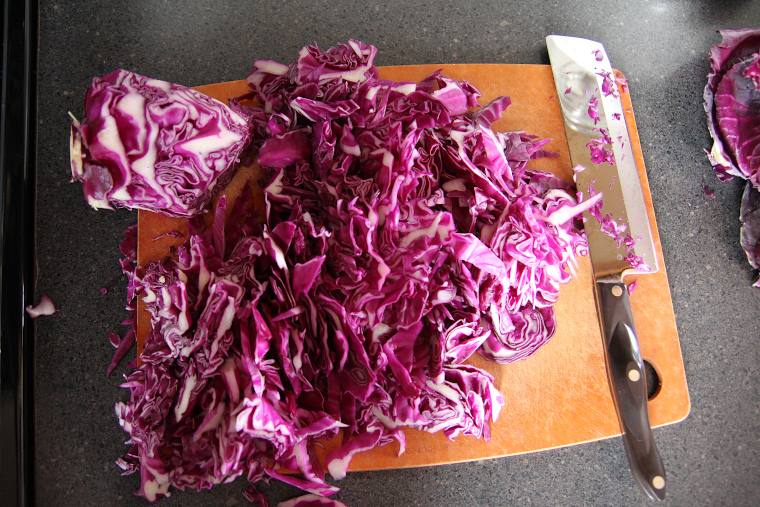
Now we’re going to dry brine our purple kraut. This just means we’re making a brine from the vegetable’s own juices rather than making a separate saltwater brine.
To do this, squeeze and massage your cabbage for several minutes with your clean hands until it releases it juices. My kids love to help with this part!

The red cabbage will stain your hands for the day, so wear food-safe gloves if you are worried about this. (Also be aware of your countertop so you don’t stain it.)
If you’ve massaged the cabbage for a while and you still feel like you’re short on brine, you can let it sit for 30 minutes or so. More water should sweat from the cabbage.
Step 2 – Pack Cabbage in Jar
Next, use your hands to pack the cabbage into your jar a little at a time, pressing it down firmly as you go. Utilize a spoon if you need to. Leave an inch or two of space at the top of the jar.
Press a glass fermentation weight down onto the cabbage to push it below the brine.
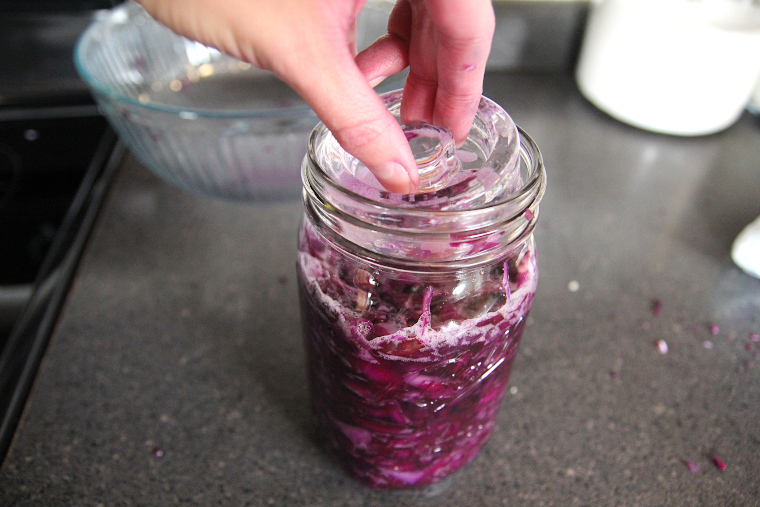
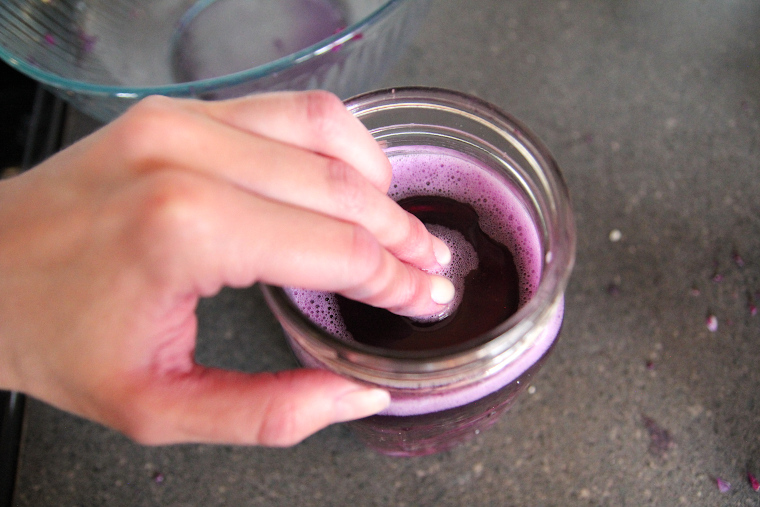
Put an airlock lid into your metal rim and screw the rim onto the jar. This will keep air out of the jar, but let gasses escape at the same time.
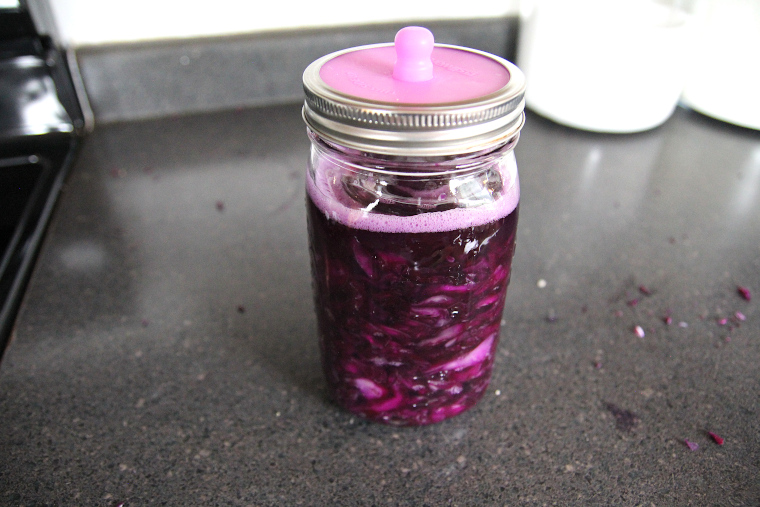
Step 3 – Ferment Purple Sauerkraut
Place your jar on a plate or in a baking dish in case any brine leaks out the top (though leaving space will help avoid this).
Now it’s time to wait.
Leave your jar at room temperature to sit for 7 days-3 weeks. (Your sauerkraut may taste tangy after day 3, but go longer so it can finish developing and preserve properly.)
You’re aiming for the temperature to stay fairly consistent between 65°-72°F. Find a place in your house that will meet this criteria or wait to make sauerkraut until autumn time.
Give your purple sauerkraut a taste after 7 days. If it tastes good to you, you can call it done. The flavors will become more complex after more time, though, and the probiotics will be more prolific with a longer ferment. 21 days is best.
If your brine disappears, I have some tips below the recipe card in the FAQs section.
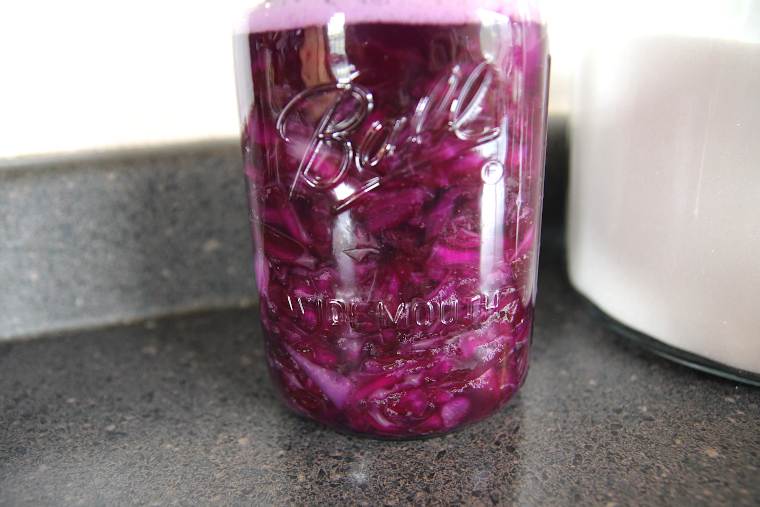
After it’s done fermenting, simply switch out the airlock lid for a plastic lid fitted snugly for storage in the refrigerator.
You can continue to use the glass weight to keep the cabbage submerged below the brine.
I’m so grateful for your comments, reviews, and questions! Your star ratings help others discover my recipes, and your feedback helps me make improvements. Thank you for your support!

Purple Sauerkraut
Make this beautiful purple sauerkraut in a jar at home with only a few supplies. It's tangy, gut-healthy, and a delicious condiment or side to add variety and color to your meals. No canning is necessary.
Ingredients
- 1 medium-sized head of red cabbage (fresh and in season is best)
- Fine sea salt
Instructions
- Remove and discard the outer leaves of your head of cabbage. Slice your cabbage thinly, avoiding the core in the bottom center. Discard core.
- Tare out your kitchen scale with a large bowl on top. Weigh your cabbage in the bowl to see how many grams you have. Multiply that number by .02 (2%). That will give you the grams of salt you need to weigh out.
- Add your salt to the cabbage. Squeeze and massage the cabbage with your hands for several minutes until you have a good amount of brine.
- Tightly pack your cabbage in a quart-size mason jar a little at a time with your fingers or a spoon until you have an inch or two of headspace. Press a glass fermentation weight onto the cabbage to force it below the brine.
- Place an airlock lid in the rim of your jar and screw the lid onto your jar. Place jar on a plate or in a baking dish in case of overflow.
- Allow jar to sit at room temperature (65°-72°F) for 7 days to 3 weeks, checking daily to make sure the cabbage remains below the brine.
- Switch out the airlock lid for a plastic lid fitted snugly, and store in the refrigerator for 3 months or more with the sauerkraut still below the brine.
Notes
1. Use clean tools but no need to sanitize them. No need to wash your cabbage since you are removing the outer leaves.
2. If your brine disappears during fermentation, press down the cabbage again with your weight to force it below the brine, or use a skewer or table knife to work out the air bubbles. If you must add more brine, use lemon juice.
3. A 21-day ferment is best, but you can stop after 7 days if you like the taste.
Recommended Products
As an Amazon Associate and member of other affiliate programs, I earn from qualifying purchases.
-
 GreaterGoods Digital Food Kitchen Scale, Multifunction Scale Measures in Grams and Ounces (Ash Grey)
GreaterGoods Digital Food Kitchen Scale, Multifunction Scale Measures in Grams and Ounces (Ash Grey) -
 Masontops Pickle Pipes - Waterless Airlock Fermentation Lids - Wide Mouth Mason Jar Fermenter Cap - Premium Silicone Top
Masontops Pickle Pipes - Waterless Airlock Fermentation Lids - Wide Mouth Mason Jar Fermenter Cap - Premium Silicone Top -
 Ball Mason Jar-32 oz. Clear Glass Ball Wide Mouth-Set of 2
Ball Mason Jar-32 oz. Clear Glass Ball Wide Mouth-Set of 2 -
 4-Pack of Fermentation Glass Weights with Easy Grip Handle for Wide Mouth Mason Jars
4-Pack of Fermentation Glass Weights with Easy Grip Handle for Wide Mouth Mason Jars -
![WIDE Mouth Mason Jar Lids [16 Pack] for Ball, Kerr and More - Food Grade White Plastic Storage Caps for Mason/Canning Jars - Leak-Proof & Anti-Scratch Resistant Surface](data:image/svg+xml,%3Csvg%20xmlns='http://www.w3.org/2000/svg'%20width='240'%20height='240'%20viewBox='0%200%20240%20240'%3E%3C/svg%3E) WIDE Mouth Mason Jar Lids [16 Pack] for Ball, Kerr and More - Food Grade White Plastic Storage Caps for Mason/Canning Jars - Leak-Proof & Anti-Scratch Resistant Surface
WIDE Mouth Mason Jar Lids [16 Pack] for Ball, Kerr and More - Food Grade White Plastic Storage Caps for Mason/Canning Jars - Leak-Proof & Anti-Scratch Resistant Surface
Purple Sauerkraut FAQs
How long does purple sauerkraut last in the fridge?
As long as it was fermented properly, it should last in the fridge for at least 3 months, but probably much longer. Make sure you always use a clean utensil to remove kraut from the jar and replace the weight and lid properly when you’re done to keep the sauerkraut submerged in the brine.
How can you tell if homemade sauerkraut has gone bad?
If it has a rotten odor, you see colorful or fuzzy mold, or it has a mushy or slimy texture, throw it out.
Kahm yeast on a ferment looks white and maybe creamy but isn’t dangerous. It can be scraped off the top if it hasn’t taken over. You can do a search on the internet to see if this is what you’re dealing with.
If foam develops on the top while the kraut ferments, this isn’t dangerous either. Just scrape it off. A little sediment seen the bottom of your jar shouldn’t be harmful either.
What if my brine disappears?
To my understanding, it is vital that the cabbage stays below the brine constantly for the first 3 days of fermentation. You can try pushing the cabbage back down under the brine with your weight, or pack it down in the jar again with a clean wooden skewer or a butter knife to get rid of air bubbles.
If you still don’t have enough brine at this point, you can add a little lemon juice. Adding plain water or saltwater brine might give you a mushy kraut.
You can try shredding your cabbage more thinly next time, let it sit after you massage it, or use fresher cabbage to help you get more brine from the get go.
After the first 3 days, it is common for the brine to be reabsorbed by the cabbage or to come and go depending on the temperature in your house. It is also common for the brine to disappear during refrigeration. If this happens when you don’t realize it, your sauerkraut should be fine as long as it doesn’t show any signs of spoilage.
Why isn’t my sauerkraut crunchy?
The temperature of your kitchen may be too warm if your kraut is turning out mushy. The ideal temperature is a consistent 65°-72°F. Also make sure you’re weighing your cabbage and salt for the proper ratio.





![WIDE Mouth Mason Jar Lids [16 Pack] for Ball, Kerr and More - Food Grade White Plastic Storage Caps for Mason/Canning Jars - Leak-Proof & Anti-Scratch Resistant Surface](https://m.media-amazon.com/images/I/41GE7an60hL._SL500_.jpg)
good morning, my jar was accidently tipped over and the brine is basically gone, should I still fill with lemon juice or create a brine with salt water? thank you
Hi there, I’m sorry to hear that! I really don’t know if that much brine could be replaced with either lemon juice or a new brine and still turn out successfully. Sorry I can’t be of more help!